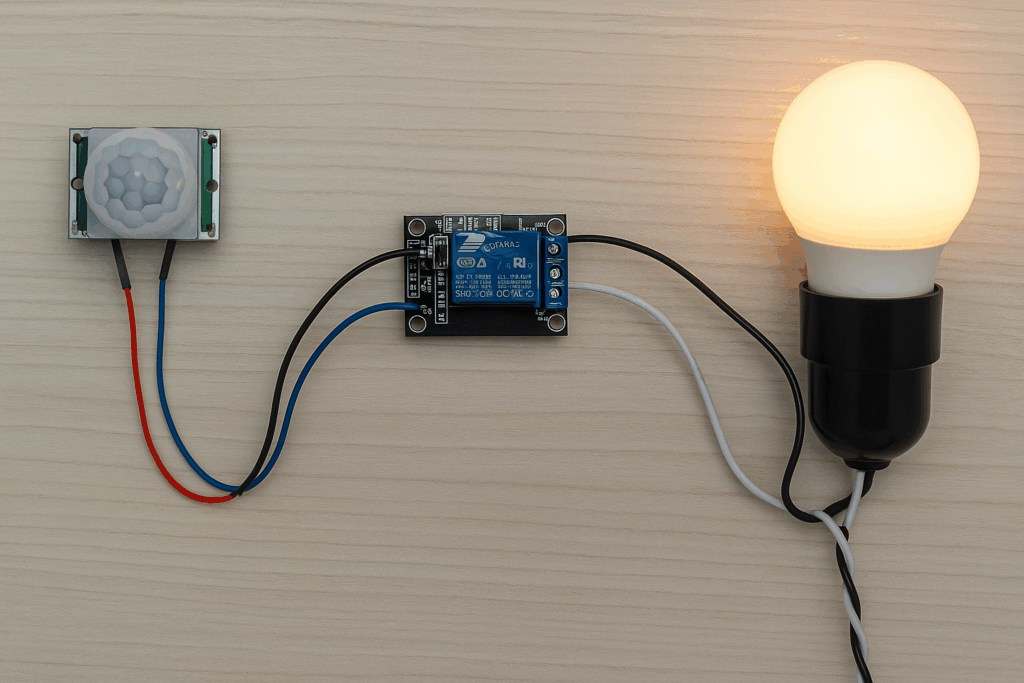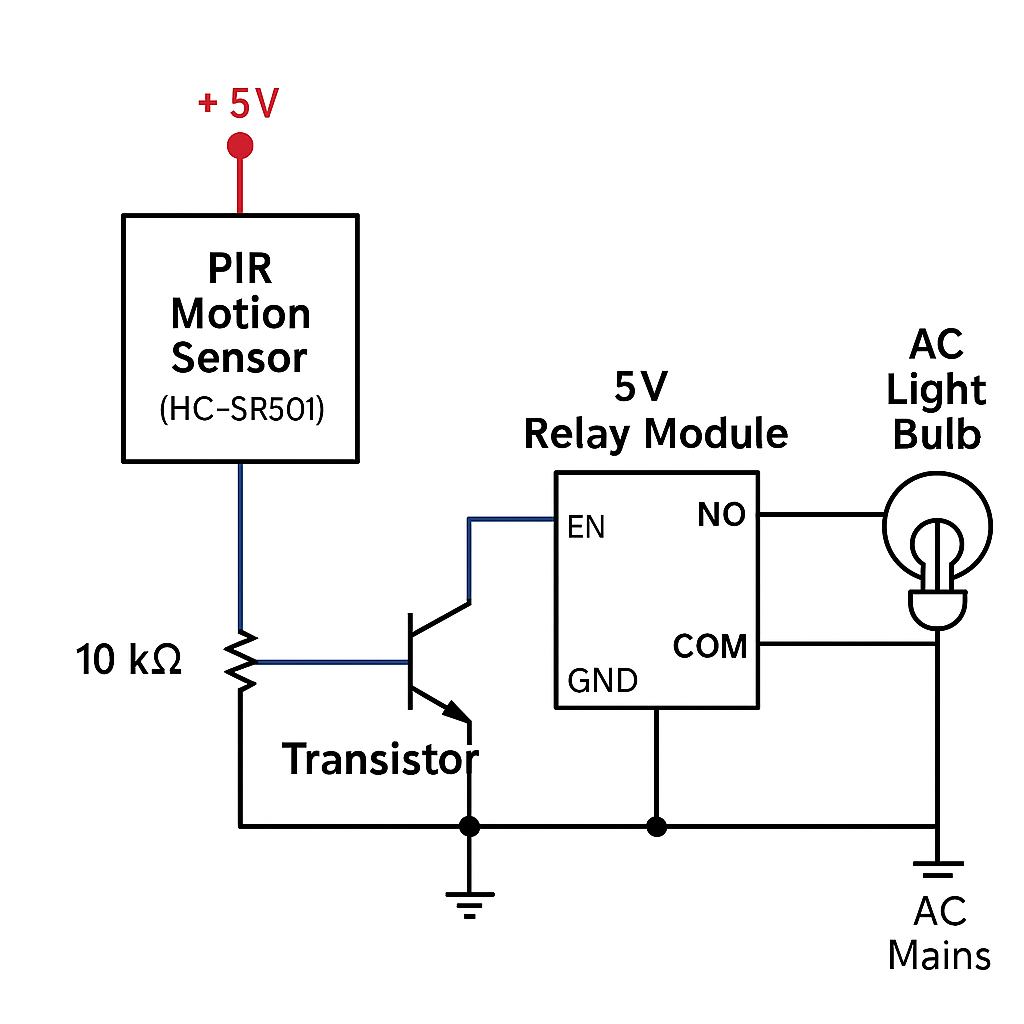
Motion sensor lights have become an essential part of modern smart homes. Whether you’re enhancing home security, automating garage lighting, or just saving on electricity bills, these lights offer incredible value. In this guide, we’ll cover everything you need to know about motion sensor lights—including how they work, their key features, and even how you can build your own DIY motion sensor light project at home.
If you’re exploring the DIY side of electronics, don’t forget to check out our Motion Sensor Light project page for detailed schematics, parts list, and video tutorials.
What is a Motion Sensor Light?
Contents
- 1 What is a Motion Sensor Light?
- 2 Key Features of Motion Sensor Lights
- 3 How Does a Motion Sensor Light Work?
- 4 How to Make a DIY Motion Sensor Light at Home
- 5 Best Use Cases for Motion Sensor Lights in the USA
- 6 FAQs About Motion Sensor Lights
- 6.1 ❓Can I use motion sensor lights indoors?
- 6.2 ❓How far can a motion sensor detect movement?
- 6.3 ❓Do motion sensor lights work during the day?
- 6.4 ❓Can I install a motion sensor light myself?
- 6.5 ❓Are motion sensor lights waterproof?
- 6.6 ❓What happens if my light keeps turning on and off?
- 6.7 ❓Can I integrate motion sensor lights with smart home systems?
- 7 Conclusion
A motion sensor light is an automated lighting system that turns on when it detects movement and turns off after a set period of inactivity. These lights are commonly installed in outdoor areas, hallways, bathrooms, garages, and stairways to increase convenience, safety, and energy efficiency.
Most modern motion sensor lights use Passive Infrared (PIR) sensors that detect heat signatures from moving humans or animals.
Key Features of Motion Sensor Lights
Here are some core features that make motion sensor lights popular in residential and commercial applications:
1. Automatic Operation
Turns on instantly when motion is detected and turns off automatically after a preset time (usually 30 seconds to 5 minutes).
2. Energy Efficient
Reduces electricity consumption by ensuring the light is on only when needed.
3. Enhanced Security
Acts as a deterrent for intruders, especially when installed around entrances, garages, and driveways.
4. Daylight Sensitivity
Many models include a Light Dependent Resistor (LDR) to ensure the sensor only activates at night.
5. Adjustable Range and Sensitivity
You can customize detection distance (typically 3-7 meters) and angle of detection (up to 180°).
6. Weatherproof Design
Outdoor models are often IP65-rated, protecting them from dust, rain, and extreme temperatures.
7. Multiple Mounting Options
Can be wall-mounted, ceiling-mounted, or placed in corners for broader coverage.
How Does a Motion Sensor Light Work?
Motion sensor lights typically use a PIR sensor to detect movement. Here’s a breakdown of how it functions:
➤ PIR Sensor Functionality
The Passive Infrared sensor detects changes in infrared radiation (heat) emitted by humans and animals. When someone enters its detection zone, it triggers the connected light circuit.
➤ LDR Integration
If an LDR is used, the system becomes intelligent enough to function only in low-light conditions—ideal for outdoor night lighting or indoor energy saving.
➤ Relay Module
The relay acts as a switch that controls the light. When the PIR sensor detects motion, it sends a signal to the relay, which then completes the circuit to power the light.
How to Make a DIY Motion Sensor Light at Home
Building your own motion sensor light is a fun and educational electronics project. Here’s a simple guide:
✅ Components Required:
| Component | Quantity | Description |
|---|---|---|
| PIR Motion Sensor | 1 | HC-SR501 PIR Sensor |
| Light Bulb/LED | 1 | AC or DC based, depending on your circuit |
| Relay Module | 1 | 5V Relay Module |
| Resistors | 2-3 | 220Ω and 10kΩ (for LED and signal conditioning) |
| Transistor (Optional) | 1 | BC547 or similar (for signal amplification) |
| Power Source | 1 | 9V Battery or 5V Adapter |
| Breadboard/Wires | As needed | For connecting components |
| Arduino Uno (Optional) | 1 | If you want to program delay or logic |
📌 You can find detailed pinout diagrams and schematics on our Motion Sensor Light project page.
🛠️ Circuit Diagram Overview

Here’s a simple non-Arduino circuit setup:
- Connect the VCC and GND of the PIR sensor to the 5V power supply.
- Connect OUT pin of the PIR sensor to the base of the transistor (through a 10kΩ resistor).
- Emitter of the transistor goes to GND.
- Collector connects to the relay input.
- The relay is wired to the light bulb and AC source.
- The LDR can be added in series with a voltage divider and connected to the transistor base to limit activation to dark environments.
💡 Pro Tip: For added safety, ensure all AC connections are properly insulated.
🧠 Working Principle
- The PIR sensor constantly scans for infrared heat changes.
- When a human walks into the detection area, the sensor sends a HIGH signal.
- This activates the relay, turning on the light.
- After a delay (built-in or external timer), the relay turns off the light if no motion is detected.
If you’re using Arduino, you can customize the ON duration and brightness or even integrate a buzzer for alerting purposes.
Best Use Cases for Motion Sensor Lights in the USA
Motion sensor lights are widely used across homes and businesses in the United States. Here are common applications:
- Outdoor security lighting
- Garage automation
- Pathway and garden lighting
- Restroom automation in offices
- Smart closets or cabinets
- Staircase lighting for safety
In states with higher crime rates or frequent power-saving initiatives like California or New York, motion sensor lights offer both protection and savings.
FAQs About Motion Sensor Lights
❓Can I use motion sensor lights indoors?
Absolutely! Many users install them in closets, bathrooms, hallways, and basements to improve convenience and energy efficiency.
❓How far can a motion sensor detect movement?
Most PIR sensors have a range of 3 to 7 meters (10–25 feet), but some advanced models offer up to 12 meters of detection.
❓Do motion sensor lights work during the day?
Some do, but many include daylight sensors (LDRs) that prevent the light from activating in bright conditions. You can choose models based on your preference.
❓Can I install a motion sensor light myself?
Yes! If you’re comfortable working with electrical components, DIY installation is straightforward. Otherwise, it’s best to consult a licensed electrician for AC installations.
❓Are motion sensor lights waterproof?
Outdoor models are waterproof, typically with IP65 ratings. Always check product specifications before installation.
❓What happens if my light keeps turning on and off?
This usually means:
- False triggers (e.g., pets, trees)
- Sensor sensitivity too high
- Malfunctioning PIR sensor
Adjusting the angle or sensitivity usually solves the problem.
❓Can I integrate motion sensor lights with smart home systems?
Yes, advanced motion lights are compatible with Alexa, Google Assistant, or smart relays. DIY versions using Arduino or ESP32 can also be programmed for smart control.
Conclusion
Motion sensor lights are a smart, cost-effective, and highly useful upgrade for any home or workspace. Whether you want to deter intruders, save electricity, or simply enjoy hands-free convenience, these lights deliver on all fronts. With the right components and a little DIY spirit, you can even build your own motion sensor lighting system using basic electronics.
Ready to build your own? Visit our Motion Sensor Light DIY project page for a full component list, wiring diagrams, and step-by-step instructions.